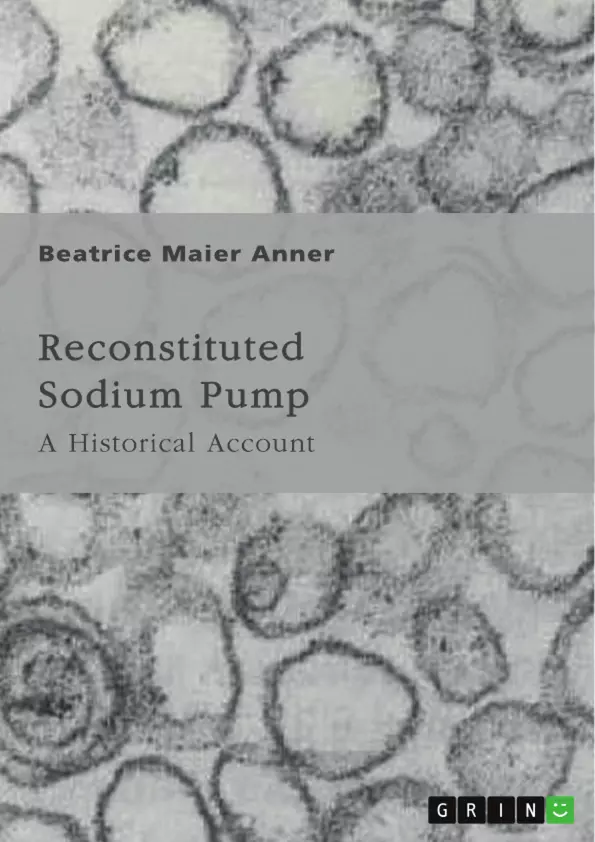The sodium pump, also called Na,K-ATPase (NKA) is a biomotor inserted in the membrane of all living cells; it extrudes sodium ions from the cell interior and replaces them with potassium ions. This is a fundamental and vital process. Furthermore, the sodium pump is also a receptor for pharmacological and toxicological compounds, such as the heart drug digitoxin and the arrow poison ouabain. Around 1974 it became possible to extract the sodium pump from the cell membrane and insert it into artificial phospholipid vesicles where it worked in the same way as in the cell. Now, the pump could be studied in its pure form on a molecular level. The author has been involved in this pioneering research and tells some fascinating stories concerning the first ultrastructural description of the reconstituted sodium pump in collaboration with specialists at Arhus University in Denmark and at Duke University in the US, and about the use of the reconstituted sodium pump for testing an unknown inhibitory compound in collaboration with Harvard Medical School.
Inhaltsverzeichnis (Table of Contents)
- PREFACE
- ACKNOWLEDGEMENTS
- ABBREVIATIONS AND DEFINITIONS
- 1 A BET ON INTRAMEMBRANE PARTICLES
- 2 TRANSATLANTIC COLLABORATION
- 3. ANOTHER TRANSATLANTIC COLLABORATION
- ANNEX 1. MORPHOMETRY AND STATISTICS
- ANNEX 2. TOOLS USED FOR MORPHOMETRY
- ANNEX 3. NANOSCALE RESOLUTION
Zielsetzung und Themenschwerpunkte (Objectives and Key Themes)
This booklet narrates the scientific journey of the reconstituted sodium pump. The work aimed to demonstrate the functional activity of the sodium pump in an artificial environment, independent of its natural cell membrane. This was an important step in understanding the fundamental mechanisms of this crucial transport system.
- Reconstitution of the sodium pump in artificial membranes
- Ultrastructural analysis of reconstituted sodium pump vesicles
- Mathematical modeling of reconstituted sodium pump vesicles
- Identification and characterization of a potent sodium pump inhibitor
- The role of metal ions in sodium pump function and toxicity
Zusammenfassung der Kapitel (Chapter Summaries)
- Chapter 1: A Bet on Intramembrane Particles: This chapter recounts the initial steps of the reconstitution research at Baylor College and the subsequent collaboration with Arhus University. It highlights the discovery of intramembrane particles representing reconstituted sodium pump molecules within artificial membranes.
- Chapter 2: Transatlantic Collaboration: This chapter details the collaboration with Duke University, where ultrastructural analysis of the reconstituted preparations was performed using high-resolution electron microscopy. The research confirmed the presence of intramembrane particles and provided a detailed characterization of the reconstituted vesicles.
- Chapter 3: Another Transatlantic Collaboration: This chapter describes a collaborative project with Garner T. Haupert, where a powerful sodium pump inhibitor, HIF, was identified and characterized. The investigation delved into the unusual properties of HIF and its implications for sodium pump function and toxicity.
Schlüsselwörter (Keywords)
The booklet focuses on sodium pump, Na,K-ATPase, reconstitution, artificial membranes, liposomes, ultrastructure, freeze fracture, intramembrane particles, morphometrics, statistical analysis, sodium pump inhibitor, HIF, metal toxicity, metal ions, sulfhydryl groups, human lymphocytes.
- Citar trabajo
- Beatrice Maier Anner (Autor), 2024, Reconstituted Sodium Pump, Múnich, GRIN Verlag, https://www.grin.com/document/1467496



